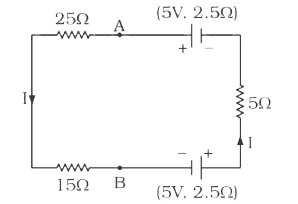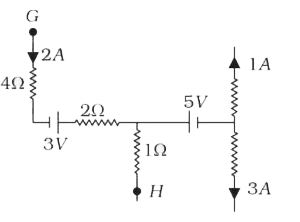If the instantaneous change on the capacitor is 100μC and current through the circuit is decreasing at the rate of 2×103 As then potential difference VA−VB is equal to _PHY_E06_046_Q01.png)
−3V
3V
27V
7V
Step by step video & image solution for If the instantaneous change on the capacitor is 100muC and current through the circuit is decreasing at the rate of 2×10^3 A/s then potential difference V_A-V_B is equal to by Physics experts to help you in doubts & scoring excellent marks in Class 12 exams.
Updated on:21/07/2023Similar Questions
If the instantaneous charge on the capacitor is (100mμC) and current through the circuit is decreasing at the rate (2×310) A/s then potential diffference (VA−VB) is equal to
View SolutionIn the given circuit, current I is 2A and it is decreasing at the rate of 103AS−1.Then VB−VA is
_PHY_E06_148_Q01.png)
View SolutionWhen the current in a certain inductor coil is 5.0A and is increasing at the rate of 10.0A/s,the magnitude of potential difference across the coil is 140V.When the current is 5.0A and decreasing at the rate of 10.0A/s,the potential difference is 60V.The self inductance of the coil is :
View SolutionThe figure shows an inductor of 2H through which a current increasing at the rate of 5A/sec is flowing.Find the potential difference VX−VY.

View SolutionIn the circuit shown, the potential difference between A and B VAandVB is equal to_______V.

View SolutionWhen the current in the portion of the circuit shown in the figure is 2A and increasing at the rate of 1A/s,the measured potential difference Va−Vb=8V.However when the current is 2A and decreasing at the rate of 1A/s, the measured potential difference Va−Vb=4V.The values of R and L are:

View SolutionA part of a complete circuit is shown in the figure . At some instant the value of current I is 1 A and it is decreasing at a rate of 102As−1 . The value of the potential difference VP−VQ, (in volts) at that instant , is ____________.

View SolutionFigure shows part of a circuit. If l = 5A and is decreasing at a constant rate of 103A/s then VB−VA is
View SolutionIn the circuit shown, the potential difference between the points G and H, VG−VH is equal to _________ V.

View SolutionIn the circuit shown in the figure , no current flows through the 8Omega resistor, then the potential difference between points A and B(V_A - V_B) is
_PHY_E01_001_Q01.png)
View Solution
